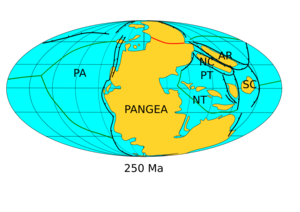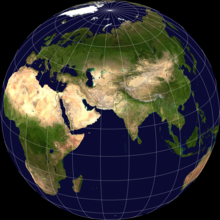
Back Superkontinent Afrikaans قارة عظمى Arabic Supercontinente AST Суперкантынент Byelorussian Суперконтинент Bulgarian অতিমহাদেশ Bengali/Bangla Dreistkevandir Breton Superkontinent BS Supercontinent Catalan Superkontinent Czech


In geology, a supercontinent is the assembly of most or all of Earth's continental blocks or cratons to form a single large landmass.[1][2][3] However, some geologists use a different definition, "a grouping of formerly dispersed continents", which leaves room for interpretation and is easier to apply to Precambrian times.[4] To separate supercontinents from other groupings, a limit has been proposed in which a continent must include at least about 75% of the continental crust then in existence in order to qualify as a supercontinent.[5]
Moving under the forces of plate tectonics, supercontinents have assembled and dispersed multiple times in the geologic past. According to modern definitions, a supercontinent does not exist today;[1] the closest is the current Afro-Eurasian landmass, which covers approximately 57% of Earth's total land area. The last period in which the continental landmasses were near to one another was 336 to 175 million years ago, forming the supercontinent Pangaea. The positions of continents have been accurately determined back to the early Jurassic, shortly before the breakup of Pangaea.[6] Pangaea's predecessor Gondwana is not considered a supercontinent under the first definition since the landmasses of Baltica, Laurentia and Siberia were separate at the time.[7]
A future supercontinent, termed Pangaea Proxima, is hypothesized to form within the next 250 million years.[8]
- ^ a b Rogers, John J. W.; Santosh, M. (2004). Continents and supercontinents. New York: Oxford University Press. ISBN 978-0195165890. Retrieved 5 January 2021.
- ^ Rogers, J.J.W.; Santosh, M. (2002). "Configuration of Columbia, a Mesoproterozoic Supercontinent" (PDF). Gondwana Research. 5 (1): 5–22. Bibcode:2002GondR...5....5R. doi:10.1016/S1342-937X(05)70883-2. Archived from the original (PDF) on 2015-02-03.
- ^ Hoffman, P.F. (1999). "The break-up of Rodinia, birth of Gondwana, true polar wander and the snowball Earth". Journal of African Earth Sciences. 28 (1): 17–33. Bibcode:1999JAfES..28...17H. doi:10.1016/S0899-5362(99)00018-4.
- ^ Bradley, D.C. (2011). "Secular Trends in the Geologic Record and the Supercontinent Cycle". Earth-Science Reviews. 108 (1–2): 16–33. Bibcode:2011ESRv..108...16B. CiteSeerX 10.1.1.715.6618. doi:10.1016/j.earscirev.2011.05.003. S2CID 140601854.
- ^ Meert, J.G. (2012). "What's in a name? The Columbia (Paleopangaea/Nuna) supercontinent". Gondwana Research. 21 (4): 987–993. Bibcode:2012GondR..21..987M. doi:10.1016/j.gr.2011.12.002.
- ^ Fluteau, Frédéric. (2003). "Earth dynamics and climate changes". C. R. Geoscience 335 (1): 157–174. doi:10.1016/S1631-0713(03)00004-X
- ^ Bradley, D. C. (23 December 2014). "Mineral evolution and Earth history". American Mineralogist. 100 (1): 4–5. Bibcode:2015AmMin.100....4B. doi:10.2138/am-2015-5101. S2CID 140191182.
- ^ Williams, Caroline; Nield, Ted (October 2007). "Earth's next supercontinent". New Scientist. 196 (2626): 36–40. doi:10.1016/S0262-4079(07)62661-X.